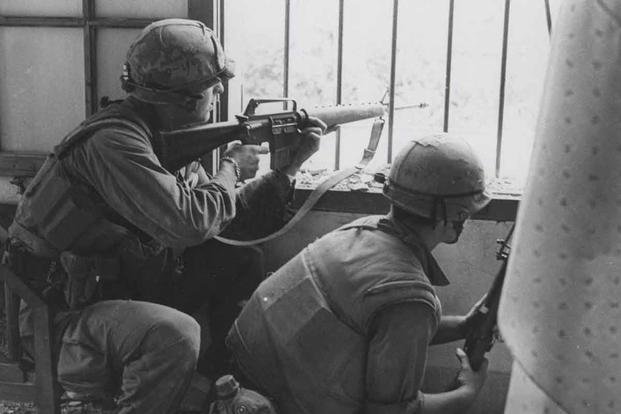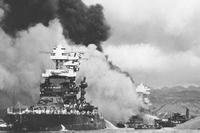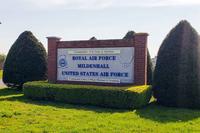Until 1945, the Vietnamese city of Hue was the capital of the country and a shining jewel in its history. The old imperial capital stood largely untouched after 150 years, even as the United States ramped up its involvement in Vietnam.
On Jan. 30, 1968, Hue became the site of one of the longest, bloodiest battles the Americans would fight against the North Vietnamese Army, or NVA, and its Viet Cong guerrillas living in South Vietnam. As part of a much larger and costly offensive, it became a turning point as public opinion in the United States began to turn against the war.
To understand why, however, there are a few critical things to understand about the battle and its aftermath.
1. Hue was untouched by the war until 1968.
After the French withdrew from Indochina, and the country was divided into a "democratic" south and a communist north, the city of Hue fell south of the demilitarized zone. As the United States increased its involvement and committed to combat actions, the city became an important part of the U.S. strategy in the country. It was an important supply point for the U.S. Navy and part of the Army's supply chain.
Until 1968, the communists were largely unable to hit major urban centers because they didn't have enough men, supplies or support inside South Vietnam's cities to make such attacks effective. They soon changed that perception.
2. The North Vietnamese weren't just a ragtag bunch of farmers.
Although the Viet Cong -- also known as the VC, they were South Vietnamese who actively supported the communist north -- had their share of peasant soldiers, North Vietnam's armed forces were much more sophisticated than popular perception allows. The north had a talented air force, weapons supplied by China and the Soviet Union, tanks, APCs, artillery and more.
More importantly, the Vietnamese had been at war against outside rule for so long, they could boast multiple generations of veteran soldiers fighting on their home turf.
3. The Battle of Hue was part of the Tet Offensive.
On Jan. 30-31, 1968, North Vietnam launched a massive, coordinated assault on nearly every city, town and military installation in South Vietnam. The communists believed it would be followed by a massive uprising against the corrupt, repressive South Vietnamese government of President Nguyen Van Thieu.
Thieu's mismanagement of the military made it much easier for the North Vietnamese Army to surprise and hit the south. As a result, Army of the Republic of South Vietnam (ARVN) forces took the brunt of the casualties. Still, it was the first time the north brought the war to the cities in any meaningful way. Some 14,300 civilians were killed, with another 24,000 wounded and 630,000 forced to flee their homes.
With his disgraceful response to the Tet Offensive, Thieu's government lost popular support in the countryside, which leaned toward the communists.
4. The United States knew an offensive was coming.
North Vietnam massed 80,000 troops and the supplies needed to launch the Tet Offensive in the days before Jan. 31, 1968. That kind of reinforcement and troop movement is hard to hide, especially when the CIA is watching the Ho Chi Minh Trail. In their history of the war, Clark Dougan and Stephen Weiss wrote that the commander of American forces in Vietnam, Gen. William Westmoreland, told Washington that he expected a "countrywide effort" from the NVA soon.
Despite the mounting evidence, in the last months of 1967, the United States and South Vietnam didn't believe an attack of the scale and scope of the Tet Offensive was possible, and were caught completely off guard.
5. Tet is a Vietnamese New Year celebration.
Vietnam has its own calendar, a lunar calendar, in which Tet marks the first day of the year. It's also one of the most important holidays in the country, on which most Vietnamese people return to their homes and immediate families to celebrate together and pay homage to their ancestors.
Launching a major offensive during the Tet holiday meant that many ARVN soldiers wouldn't be at their regular posts, and many were actually on leave at the time. When the attack came, leave was canceled, but the cancellations came too late and many soldiers went on leave anyway. To make matters worse, Westmoreland believed the focus of the attack was on Khe Sanh, when it was really Saigon.
6. It did not go well for North Vietnam.
As far as traditional military thought goes, the North Vietnamese were soundly beaten. Almost overnight, the tide turned against the communists. American and ARVN forces pushed them out of most major cities and towns. Within two weeks, an estimated 32,000 NVA troops had been killed. No South Vietnamese uprising ever came, and the Americans and South Vietnam suffered only around 1,500 and 2,700 casualties, respectively.
But not in Hue, the ancient capital city and the least likely target of an NVA attack. American and South Vietnamese defenders were caught completely off guard, and the North Vietnamese quietly captured the city with few major firefights. In journalist Mark Bowden's book "Hue 1968," the author says the city was captured in four hours, save for a small ARVN contingent inside the city's citadel and the American Military Assistance Command Vietnam (MACV) base, where "400 American troops ... were basically holed up like the Alamo."

7. Hue was the single bloodiest battle of the Vietnam War.
According to Bowden's research, the Americans believed Hue was held by a handful of die-hard communist troops and sent small units of U.S. Marines to clear them out. The Marines were instead facing a dug-in and heavily armed NVA stronghold -- and took heavy casualties doing it. The Marines were able to come to the aid of the MACV compound and other MACV elements, but not all of them.
For an entire month, U.S. Marines and soldiers, along with ARVN troops, waged battles throughout the city, often going house to house to remove Hue from North Vietnamese control. It was the first time Marines had engaged in urban combat since the Korean War. They were so unprepared for fighting in a major city that Col. Ernie Cheatham, commander of the 2nd Battalion, 5th Marines in Hue City, had to look up how to do it in an old Marine Corps field manual.
8. Hue was a loss for North Vietnam, but it marked the beginning of the end.
Even Americans who initially supported the war in Vietnam were shocked by the bloodiness of the Tet Offensive, especially the fighting in Khe Sanh (which raged on for months) and in Hue. One of those Americans was journalist Walter Cronkite, who had accepted what the government told him about the war.
It was after he landed in Hue to see the war for himself that he delivered the broadcast that many believe is the reason the United States could not achieve its objectives in Vietnam:
"[I]t seems now more certain than ever that the bloody experience of Vietnam is to end in a stalemate. … [I]t is increasingly clear to this reporter that the only rational way out then will be to negotiate, not as victors, but as an honorable people who lived up to their pledge to defend democracy, and did the best they could."
-- Blake Stilwell can be reached at blake.stilwell@military.com. He can also be found on Twitter @blakestilwell or on Facebook.
Want to Learn More About Military Life?
Whether you're thinking of joining the military, looking for post-military careers or keeping up with military life and benefits, Military.com has you covered. Subscribe to Military.com to have military news, updates and resources delivered directly to your inbox.
















